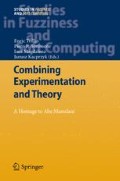Abstract
Fuzzy rules, doubtlessly one of the most powerful tools of fuzzy logic, have not only been used successfully in established application areas like control engineering and approximate reasoning, but more recently also in the field of data mining. In this chapter, we provide a synthesis of different approaches to fuzzy association analysis, that is, the data-driven extraction of interesting patterns expressed in the form of fuzzy rules. In this regard, we highlight a specific advantage of a fuzzy in comparison to a conventional approach, namely an increased expressiveness that allows for representing patterns of interest in a more distinctive way. Therefore, we specifically focus on the modeling of a less common type of pattern, namely gradual dependencies between attributes in a data set.
Access this chapter
Tax calculation will be finalised at checkout
Purchases are for personal use only
Preview
Unable to display preview. Download preview PDF.
References
Agrawal, R., Srikant, R.: Fast algorithms for mining association rules. In: Proceedings of the 20th Conference on VLDB, Santiago, Chile, pp. 487–499 (1994)
Babuska, R.: Fuzzy Modeling for Control. Kluwer Academic Publishers, Boston (1998)
Berzal, F., Cubero, J.C., Sanchez, D., Serrano, J.M., Vila, M.A.: An alternative approach to discover gradual dependencies. Int. Journal of Uncertainty, Fuzziness and Knowledge-based Systems 15(5), 559–570 (2007)
Bodenhofer, U.: Representations and constructions of similarity-based fuzzy orderings. Fuzzy Sets and Systems 137, 113–136 (2003)
Bodenhofer, U., Demirci, M.: Strict fuzzy orderings with a given context of similarity. Int. J of Uncertainty, Fuzziness and Knowledge-Based Systems 16(2), 147–178 (2008)
Bodenhofer, U., Klawonn, F.: Robust rank correlation coefficients on the basis of fuzzy orderings: Initial steps. Mathware & Soft Computing 15, 5–20 (2008)
Chen, G., Wei, Q., Kerre, E., Wets, G.: Overview of fuzzy associations mining. In: Proc. ISIS–2003, 4th International Symposium on Advanced Intelligent Systems, Jeju, Korea (September 2003)
Delgado, M., Marin, N., Sanchez, D., Vila, M.: Fuzzy association rules: general model and applications. IEEE Transactions on Fuzzy Systems 11(2), 214–225 (2003)
Dubois, D., Hüllermeier, E., Prade, H.: A systematic approach to the assessment of fuzzy association rules. Data Mining and Knowledge Discovery 13(2), 167–192 (2006)
Dubois, D., Prade, H.: Gradual inference rules in approximate reasoning. Information Sciences 61(1,2), 103–122 (1992)
Dubois, D., Prade, H.: What are fuzzy rules and how to use them. Fuzzy Sets and Systems 84, 169–185 (1996)
Fayyad, U., Piatetsky-Shapiro, G., Smyth, P.: From data mining to knowledge discovery: An overview. In: Advances in Knowledge Discovery and Data Mining, pp. 1–34. MIT Press (1996)
Frank, A., Asuncion, A.: UCI machine learning repository (2010)
Goodman, L.A., Kruskal, W.H.: Measures of Association for Cross Classifications. Springer, New York (1979)
Hüllermeier, E.: Implication-based fuzzy association rules. In: Siebes, A., De Raedt, L. (eds.) PKDD 2001. LNCS (LNAI), vol. 2168, pp. 241–252. Springer, Heidelberg (2001)
Hüllermeier, E.: Association rules for expressing gradual dependencies. In: Elomaa, T., Mannila, H., Toivonen, H. (eds.) PKDD 2002. LNCS (LNAI), vol. 2431, pp. 200–211. Springer, Heidelberg (2002)
Hüllermeier, E.: Mining implication-based fuzzy association rules in databases. In: Proceedings IPMU 2002, 9th International Conference on Information Processing and Management of Uncertainty in Knowledge-Based Systems, Annecy, France, pp. 101–108 (July 2002)
Hüllermeier, E.: Fuzzy sets in machine learning and data mining: Status and prospects. Fuzzy Sets and Systems 156(3), 387–406 (2005)
Hüllermeier, E., Yi, Y.: In defense of fuzzy association analysis. IEEE Transactions on Systems, Man, and Cybernetics–Part B: Cybernetics 37(4), 1039–1043 (2007)
Koh, H.W., Hüllermeier, E.: Mining gradual dependencies based on fuzzy rank correlation. In: Proceedings SMPS 2010, 5th International Conference on Soft Methods in Probability and Statistics, Tolouse, France (2010)
MacVicar-Whelan, P.: Fuzzy sets, the concept of height, and the hedge very. IEEE Trans. Systems, Man and Cybernetics 8, 507–511 (1978)
Mamdani, E., Assilian, S.: An experiment in linguistic synthesis with a fuzzy logic controller. International Journal of Man-Machine Studies 7, 1–13 (1975)
Michels, K., Klawonn, F., Kruse, R., Nrnberger, A.: Fuzzy Control. Springer, Heidelberg (2006)
Prade, H.: Raisonner avec des règles d’inférence graduelle - Une approche basée sur les ensembles flous. Revue d’Intelligence Artificielle 2(2), 29–44 (1988)
Savasere, A., Omiecinski, E., Navathe, S.: An efficient algorithm for mining association rules in large databases. In: VLDB 1995, Proceedings of 21st International Conference on Very Large Data Bases, Zurich, pp. 432–444 (September 1995)
Sudkamp, T.: Examples, counterexamples, and measuring fuzzy associations. Fuzzy Sets and Systems 149(1), 57–71 (2005)
Zadeh, L.A.: A fuzzy-set theoretic interpretation of linguistic hedges. J. Cybernetics 2(3), 4–32 (1972)
Author information
Authors and Affiliations
Corresponding author
Editor information
Editors and Affiliations
Rights and permissions
Copyright information
© 2012 Springer-Verlag Berlin Heidelberg
About this chapter
Cite this chapter
Hüllermeier, E. (2012). Fuzzy Rules in Data Mining: From Fuzzy Associations to Gradual Dependencies. In: Trillas, E., Bonissone, P., Magdalena, L., Kacprzyk, J. (eds) Combining Experimentation and Theory. Studies in Fuzziness and Soft Computing, vol 271. Springer, Berlin, Heidelberg. https://doi.org/10.1007/978-3-642-24666-1_9
Download citation
DOI: https://doi.org/10.1007/978-3-642-24666-1_9
Published:
Publisher Name: Springer, Berlin, Heidelberg
Print ISBN: 978-3-642-24665-4
Online ISBN: 978-3-642-24666-1
eBook Packages: EngineeringEngineering (R0)

